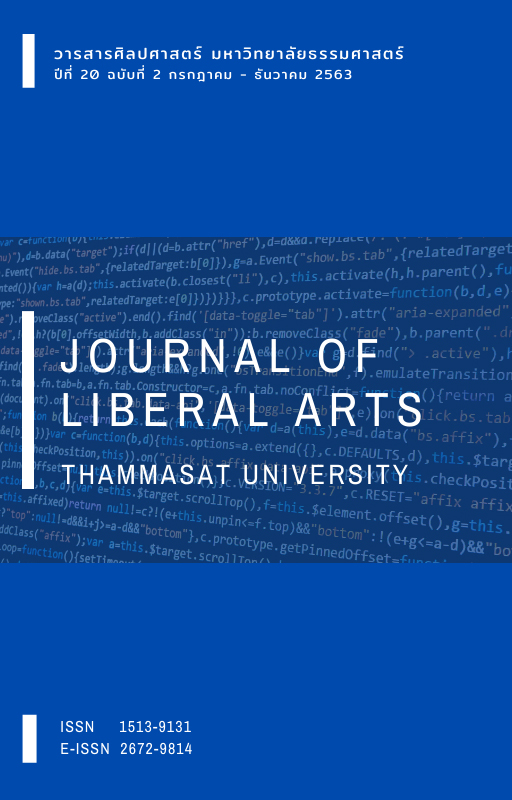วาทกรรมและอุดมการณ์เกี่ยวกับป่าในสังคมไทย
Main Article Content
บทคัดย่อ
บทความนี้มีวัตถุประสงค์เพื่อศึกษาการสื่อความหมายเกี่ยวกับป่าและ ป่าไม้จากวาทกรรมสาธารณะและวาทกรรมในชุมชนว่าการสื่อความหมายเหล่านั้นแสดงอุดมการณ์เกี่ยวกับป่าอย่างไรในสังคมไทย โดยใช้แนวคิดวาทกรรมวิเคราะห์เชิงวิพากษ์ ข้อมูลที่ใช้วิเคราะห์เป็นข้อมูลเอกสารที่เผยแพร่ผ่านสื่อสาธารณะและข้อมูลจากการสัมภาษณ์ประชาชนในพื้นที่ ข้อมูลเอกสาร ได้แก่ ตัวบทกฎหมายเกี่ยวกับป่าและป่าไม้ จำนวน 6 ฉบับ ข่าวหนังสือพิมพ์ที่เผยแพร่ระหว่างเดือนมิถุนายน 2558 ถึงเดือนมิถุนายน 2559 จำนวน 48 ข่าว ส่วนข้อมูลจากวาทกรรมในพื้นที่ที่มีประเด็นเกี่ยวกับป่า คือ ประชาชนจากชุมชนบ้านพี้เหนือ ต.บ้านพี้ อ.บ้านหลวง จ.น่าน ซึ่งมีประเด็นปัญหาเกี่ยวกับป่าที่ปรากฏในข่าว
ผลการศึกษาการวิเคราะห์ตัวบท ด้านกลวิธีการอ้างถึง การใช้ภาคแสดง กลวิธีขยายความ และการใช้สหบท ที่สื่อความหมายเกี่ยวกับป่า พบว่าลักษณะภาษาเหล่านี้ทำให้เห็นความหมายเกี่ยวกับป่าและป่าไม้ต่างกันไปตามประเภทของตัวบทที่มีผู้ผลิตตัวบทต่างกัน ในแง่ของการตีความอุดมการณ์พบว่า อุดมการณ์สิ่งแวดล้อมเป็นอุดมการณ์ที่สอดคล้องกันของทุกกลุ่มที่มุ่งนำเสนอความหมายของป่าและความเป็นธรรมชาติที่สัมพันธ์กับสิ่งแวดล้อม อย่างไรก็ดีงานวิจัยนี้เห็นว่าเป็นน้ำเสียงที่เชื่อมโยงกับบริบทของโลกมากกว่าบริบทเฉพาะถิ่น
Downloads
Article Details
เอกสารอ้างอิง
กมลธรรม ชื่นพันธุ์. (2539). การศึกษาคำศัพท์เกี่ยวกับป่าชุมชนและการอนุรักษ์สิ่งแวดล้อมของชาวเมี่ยน (วิทยานิพนธ์ปริญญามหาบัณฑิต). มหาวิทยาลัยมหิดล, กรุงเทพฯ.
กฤษดาวรรณ หงศ์ลดารมภ์. (2543). ปริจเฉทเกี่ยวกับคนกลุ่มน้อยในประเทศไทย การศึกษาความสัมพันธ์ระหว่างภาษากับอุดมการณ์ (รายงานการวิจัย). กรุงเทพฯ: คณะอักษรศาสตร์ จุฬาลงกรณ์มหาวิทยาลัย.
จันทิมา อังคพณิชกิจ. (2562). การวิเคราะห์ข้อความ (พิมพ์ครั้งที่ 2). กรุงเทพฯ: สำนักพิมพ์มหาวิทยาลัยธรรมศาสตร์.
จันทิมา เอียมานนท์. (2549). การศึกษาวาทกรรมเกี่ยวกับผู้ติดเชื้อเอดส์ในสังคมไทยตามแนว ปฏิพันธวิเคราะห์ (วิทยานิพนธ์ปริญญาดุษฎีบัณฑิต). จุฬาลงกรณ์มหาวิทยาลัย, กรุงเทพฯ.
ไชยรัตน์ เจริญสินโอฬาร. (2554). วาทกรรมการพัฒนา: อำนาจ ความรู้ ความจริง เอกลักษณ์ และความเป็นอื่น (พิมพ์ครั้งที่ 5). กรุงเทพฯ: วิภาษา.
ดีอนา คาซา (2557). การวิเคราะห์วาทกรรมเชิงวิพากษ์เกี่ยวกับอัตลักษณ์ความเป็นเกาหลีในนิตยสารบันเทิงเกาหลีที่ตีพิมพ์เป็นภาษาไทย (วิทยานิพนธ์ปริญญามหาบัณฑิต). มหาวิทยาลัยธรรมศาสตร์, กรุงเทพฯ.
ธัญญา สังขพันธานนท์. (2556). วรรณคดีสีเขียว กระบวนทัศน์และวาทกรรมธรรมชาติในวรรณคดีไทย. กรุงเทพฯ: นาคร.
มติชนออนไลน์. (สิงหาคม 2558). “ยายวัย 70 ปีมึน ถูกป่าไม้ยึดที่ดินมรดกทำกินมาเกือบ 100 ปี อ้างนโยบายทวงคืนผืนป่า.” สืบค้นเมื่อวันที่ 15 กันยายน 2558, จาก http://www.matichon.co.th/news_detail.php?newsid=1440219645
ศยามล ไกยูรวงศ์ และพรพนา ก๊วยเจริญ (บรรณาธิการ). (2548). การเมืองป่าไม้ไทยยุคหลังสัมปทาน. กรุงเทพฯ: มูลนิธิชีวิตและฟื้นฟูธรรมชาติ.
สมชาย ปรีชาศิลปกุล. (16 ธันวาคม 2557). ความเฟื่องฟูและความตกต่ำของขบวนการสิทธิชุมชนดิน-น้ำ-ป่า. วิภาษา, 2557, 17-23.
สุเนตร ชุตินธรานนท์ และคณะ. (2557). ชาตินิยมในแบบเรียนไทย. กรุงเทพฯ: มติชน.
เสน่ห์ จามริก และยศ สันตสมบัติ (บรรณาธิการ). (2536). ป่าชุมชนในประเทศไทย: แนวทาง การพัฒนาเล่ม 2 ป่าชุมชนภาคเหนือ ศักยภาพขององค์กรชาวบ้านในการจัดการป่าชุมชน (พิมพ์ครั้งที่ 2). ขอนแก่น: สถาบันชุมชนท้องถิ่นพัฒนา.
อัจฉรา รักยุติธรรม. (2556). พื้นที่สูงท่ามกลางการช่วงชิง: ความหมายของข้าวโพดเลี้ยงสัตว์และอัตลักษณ์ของชาวนาบนพื้นที่สูง (วิทยานิพนธ์ปริญญามหาบัณฑิต). มหาวิทยาลัย เชียงใหม่, เชียงใหม่.
อานันท์ กาญจนพันธุ์ และมิ่งสรรพ์ ขาวสอาด. (2558). วิวัฒนาการของการบุกเบิกที่ดินทำกินในเขตป่า: กรณีศึกษาภาคเหนือตอนบน. กรุงเทพฯ: สถาบันวิจัยเพื่อการพัฒนาประเทศ.
เอกชัย เอื้อธารพิสิฐ. (2545). สวนสัตว์: มายาคติว่าด้วยธรรมชาติและสัตว์ป่า (วิทยานิพนธ์ปริญญามหาบัณฑิต). มหาวิทยาลัยธรรมศาสตร์, กรุงเทพฯ.
Bloor, M., & Bloor, T. (2007). The Practice of Critical Discourse Analysis: An Introduction. London: Hodder Arnold.
Fennell, D. A. (2008). Ecotourism: An Introduction (3rd edition). London: Routledge.
Fairclough, N. (1992). Discourse and Social Change. Cambridge: Polity.
Greider, T., & Garkovich, L. (1994). Landscapes: The social construction of nature and the environment. Rural Sociology, 59(1), 1-24.
Halliday, M. A. K., & Hasan, R. (1985). Language: Context and Text. Burwood, Vic: Deaken University.
Halliday, M. A. K. (1978). Language as Social Semiotic: the Social Interpretation of Language and Meaning. London: Edward Arnold.
Halliday, M. A. K. (2014). Introduction to Functional Grammar (4th edition). London: Routledge.
Johnstone, B. (2008). Discourse Analysis (2nd edition). Malden, MA: Blackwell.
Mesthrie, R. (2001). Critical Sociolinguistics: Approaches to language and power. In Mesthrie, R., Swann, J., & Leap, W. (Eds.). Introducing Sociolinguistics (pp. 309-343). Edinburgh: Edinburgh University Press.
Schiffrin, D., Tannen, D., & Hamilton, H. (2003). Introduction. In D. Schiffrin, D. Tannen, & H. Hamilton (Eds.), The Handbook of Discourse Analysis (pp.1-10). Blackwell: Oxford.
Scollon, R., Scollon, S. W., & Jones, R. H. (2012). Intercultural Communication: An Discourse Approach (3rd edition). London: Wiley-Blackwell.
Searle, J. R. (1969). Speech Acts: An Essay in the Philosophy of Language. Cambridge: Cambridge University Press.
Stibbe, A. (2015). Ecolinguistics: Language, Ecology and the Stories We Live By. London: Routledge.
van Dijk, T. A. (2006). Discourse and manipulation. Discourse and Society, 17(3), 359-383.
van Dijk, T. A. (2008). Discourse and Context: A Sociocognitive Approach. Cambridge: Cambridge University Press.
Wenger, E. (1998). Communities of Practice: Learning, Meaning, and Identity. Cambridge: Cambridge University Press.
Wolf, A. S., & Klein, A. J. (2007). Enter the working forest: Discourse analysis in the northern forest. Geoforum, 38, 985-998.
Wood, T. J. (2004). Communication theories in action: An introduction. Boston: WADSWORTH.


